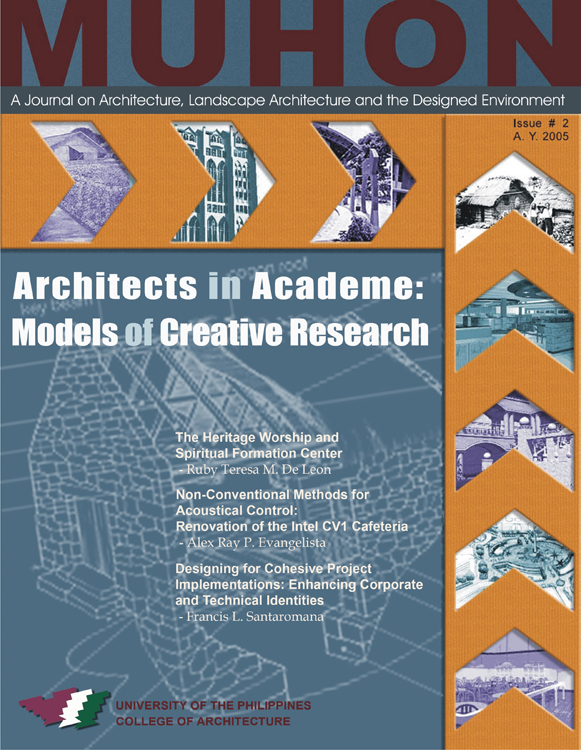The Filipino Spirit in the Making of Space: An Overview
Abstract
What makes a place? What makes space? In particular, what makes a space Filipino? This paper proposes that it is not rationality or logic of form that dictates the making of a Filipino architecture but, rather, the unseen core of the Filipino being, diwa, which determines the visible form and, more significantly, the intangible space at its core. The author uses a model, derived from Jocano’s model of the Filipino value system, to illustrate the various levels at which the diwa manifests itself and the corresponding architectural expressions that result. This paper is a work preliminary to a larger study in which the author hopes to derive a theory of Filipino place-making that is more cognizant of a Filipino spirituality of being than the current Western standards by which Filipino architecture is currently being criticized.
Webster’s New Dictionary of Synonyms provides the following entry: “Architecture, architectonics and their corresponding adjectives architectural and architectonic are often indistinguishable, but they tend to diverge in emphasis. The nouns mean the science of planning and building structures (as churches, houses, bridges, and ships) that involve problems of artistic design, engineering, and adaptation to the ends in view”. In relation, Vitruvius holds that an architect must be well versed in the following areas of knowledge: drawing, geometry, optics, history, philosophy, music, medicine and astronomy. Further, the following statements are made by author Garry Stevens in his work, The Reasoning Architect: Mathematics, Science and Art in Architecture: “Consider, for example, the methods that we use to ensure that buildings stay up. First, we assume that there are such methods…second, there is a causal connection between what we do, the materials that we use, and their sizes and the ability of a structure to remain upright…Third, this reason involves properties of the structure, the beam, and the forces acting on it…Fourth, the reasons behind the structure’s behavior are discoverable by engineers or scientists…Fifth, we can predict the behavior of the beam...Sixth, we can use all this knowledge to alter the structure, to manipulate it to suit our purposes… (Now consider that) events that fall into patterns or regularities that are the product of rules and natural laws, that an invocation of these rules is the only legitimate explanation of these events, and that these rules can be discovered and understood by humanity, which can then use them to change the world.”
Given all the above it appears, then, that the popular and, in many institutions, academic view of architecture is one of reason, logic, and rationality. Decisions in the design process should be made by deduction and conscious knowledge. Structures must be built by the reasoning mind and even beauty must be subject to theoretical principles. That is, if the work is to be considered architecture at all.
In contrast, consider the following by Bachelard in his Poetics of Space:
“…all really inhabited space bears the essence of the notion of home…The sheltered being gives perceptible limits to his shelter. He experiences the house in its reality and its virtuality, by means of thought and dreams ”.
For millions of years man has made space as an expression of himself, deciding how he is to determine the areas of his cave dwelling or the form of his hut. Rationality may have been used in the practical considerations of shelter from the elements but the impetus, the driving force that dictates the intuitive rightness or wrongness of his space are certainly not dictates of his logic. Why, then, does man make space the way he does?
This paper proposes that it is nothing less than man’s innate spirituality that dictates the creation of his tangible and intangible spaces. Individual, cultural, and universal aspects of spirituality, as defined later, are seen to be the forces that determine man’s perception of himself, others, and the universe and the impetus to his reflection of this in his architecture. This work hopes to provide a preliminary overview of the topic by examining the phenomenon of Filipino spirituality and its reflections in Filipino architecture. In the following discourse cultural manifestations of this spirituality are discussed and inferential relationships to the ways the Filipino defines his space are determined. In this way a possible direct conclusion may be made on cultural spirituality as the major determinant of the way we, as Filipinos, make space preparatory to further explorations and discourse on the relationship of spirituality and space on individual and, further, universal levels.
The copyright for the published work belongs to UPCA and its selected publisher. The contributor is free to publish a modified version of the same article in other publications.
The contributor guarantees that :
- the article does not infringe on the copyright or any proprietary right of any other person
- the article contains no libelous or other unlawful matter
- the article makes no improper invasion of the privacy of any other person.





